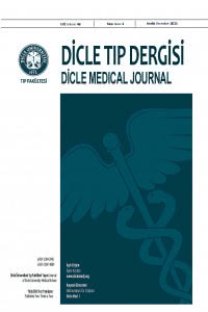Astımlılarda inhaler kortikosteroid kullanımı glukoz tolerans bozukluğu yapıyor mu?
Astım, Adrenal korteks hormonları, Glukoz tolerans testi, Nebülizerler ve vaporizerler
May inhaled corticosteroid use give rise to impaired glucose tolerance in bronchial asthma?
___
- 1. Leone FT, Fish JE, Szefler SJ, West SL. Systematic review of the evidence regarding potential complications of inhaled corticosteroid use in asthma: collaboration of American College of Chest Physicians, American Academy of Allergy, Asthma, and Immunology, and American College of Allergy, Asthma, and Immunology. Chest. 2003; 124:2329-40.
- 2. Delaunay F, Khan A, Cintra A, et al. Pancreatic beta cells are important targets for the diabetogenic effects of glucocorticoids. J Clin Invest. 1997; 100:2094-8.
- 3. Conn HO, Poynard T. Corticosteroids and peptic ulcer: meta-analysis of adverse events during steroid therapy. J Intern Med. 1994; 236:619-32.
- 4. Post-transplant diabetes mellitus. The role of immunosuppression. Jindal RM, Sidner RA, Milgrom ML. Drug Saf. 1997; 16:242-57.
- 5. Faul JL, Cormican LJ, Tormey VJ, et al. CDeteriorating diabetic control associated with high-dose inhaled budesonide. Eur Respir J. 1999; 14:242-3.
- 6. Faul JL, Tormey W, Tormey V, Burke C. High dose inhaled corticosteroids and dose dependent loss of diabetic control. BMJ. 1998; 317:1491.
- 7. Blackburn D, Hux J, Mamdani M Quantification of the Risk of Corticosteroidinduced Diabetes Mellitus Among the Elderly. J Gen Intern Med. 2002; 17:717-20.
- 8. Wright NP, Wales JK.The incidence of hypoglycaemia in children with type 1 diabetes and treated asthma. Arch Dis Child. 2003;88:155-6.
- 9. Smith AP, Banks J, Buchanan K, Cheong B, Gunawardena KA. Mechanisms of abnormal glucose metabolism during the treatment of acute severe asthma. Q J Med. 1992; 82:71-80.
- 10. Pethica BD, Penrose A, MacKenzie D, et al. Comparison of potency of inhaled beclomethasone and budesonide in New Zealand: retrospective study of computerised general practice records. BMJ. 1998; 317:986-90.
- 11. van Staa TP, Leufkens HG, Abenhaim L, et al. Use of oral corticosteroids in the United Kingdom. QJM. 2000; 93:105-11.
- 12. Dendukuri N, Blais L, LeLorier J. Inhaled corticosteroids and the risk of diabetes among the elderly. Br J Clin Pharmacol. 2002; 54:59-64.
- 13. Skorodin MS. Pharmacotherapy for asthma and chronic obstructive pulmonary disease. Current thinking, practices, and controversies. Arch Intern Med. 1993; 153:814-28.
- 14. Wilson AM, Lipworth BJ. Short-term dose-response relationships for the relative systemic effects of oral prednisolone and inhaled fluticasone in asthmatic adults. Br J Clin Pharmacol. 1999; 48:579-85.
- 15. Lipworth BJ. Systemic adverse effects of inhaled corticosteroid therapy: A systematic review and meta-analysis. Arch Intern Med. 1999 May 10;159:941-55.
- 16. Chestte ki kaynak Kinberg KA, Hopp RJ, Biven RE, Gallagher JC. Bone mineral density in normal and asthmatic children. J Allergy Clin Immunol. 1994; 94: 490-7.
- 17. Chesteki kaynak Heuck C, Wolthers OD, Kollerup G, et al. Adverse effects of inhaled budesonide (800 micrograms) on growth and collagen turnover in children with asthma: a double-blind comparison of oncedaily versus twice-daily administration. J Pediatr. 1998; 133: 608-12.
- ISSN: 1300-2945
- Yayın Aralığı: 4
- Başlangıç: 1963
- Yayıncı: Cahfer GÜLOĞLU
Bir olgu nedeniyle abdominal epilepsi
MEHMET CUDİ TUNCER, Orhan TACAR, E. Savaş HATİPOĞLU
Astımlılarda inhaler kortikosteroid kullanımı glukoz tolerans bozukluğu yapıyor mu?
Nurhan KÖKSAL, Mehmet Akif BÜYÜKBEŞE, Ali ÇETİNKAYA, FATMA İNANÇ TOLUN
H. Coşkun ÇELİK, Ömer SATICI, M. Yusuf ÇELİK
Diyarbakır'da 1996-98 yılları arasında saptanan medikolegal ölümlerin tanımlanması
Mehmet TATLI, ASLAN GÜZEL, Ebru GÜZEL
Bilateral Swyer-James (Macleod's) sendromu (Bir olgu nedeniyle)
Ömer ÖZBUDAK, Ahmet USLU, Aykut ÇİLLİ, Candan ÖĞÜŞ, Canan SEZER, Tülay ÖZDEMİR
The effects of enalapril maleate and cold stress on some blood parameters
ZELİHA SELAMOĞLU, MUHİTTİN YÜREKLİ
Bilateral Swyer-James (Macleod's) sendromu (Bir olgu nedeniyle)
Canan SEZER, Candan ÖĞÜŞ, Tülay ÖZDEMİR, Ömer ÖZBUDAK, Ahmet USLU, Aykut ÇİLLİ
